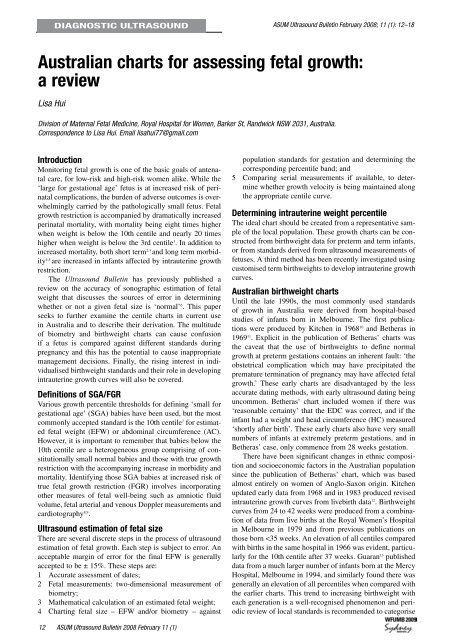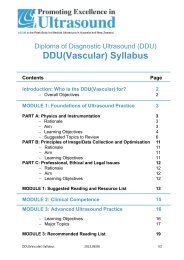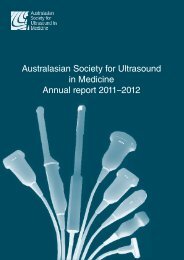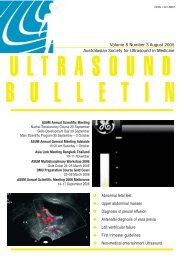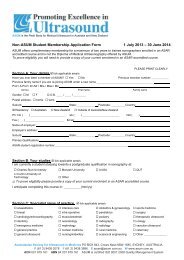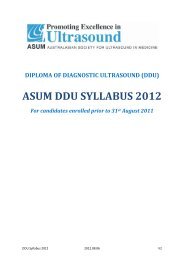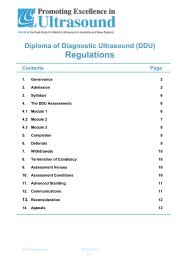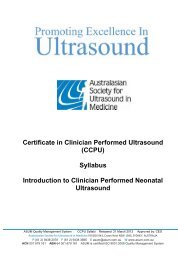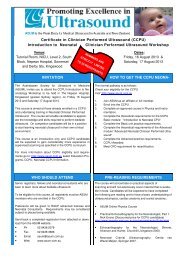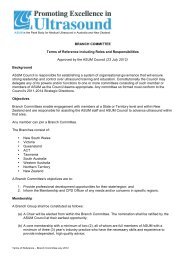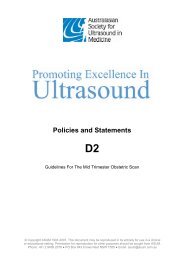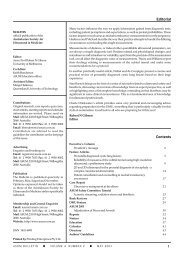Volume 11 Issue 1 (February) - Australasian Society for Ultrasound ...
Volume 11 Issue 1 (February) - Australasian Society for Ultrasound ...
Volume 11 Issue 1 (February) - Australasian Society for Ultrasound ...
You also want an ePaper? Increase the reach of your titles
YUMPU automatically turns print PDFs into web optimized ePapers that Google loves.
DIAGNOSTIC ULTRASOUND<br />
ASUM <strong>Ultrasound</strong> Bulletin <strong>February</strong> 2008; <strong>11</strong> (1): 12–18<br />
Australian charts <strong>for</strong> assessing fetal growth: <br />
a review<br />
Lisa Hui<br />
Division of Maternal Fetal Medicine, Royal Hospital <strong>for</strong> Women, Barker St, Randwick NSW 2031, Australia.<br />
Correspondence to Lisa Hui. Email lisahui77@gmail.com<br />
Introduction<br />
Monitoring fetal growth is one of the basic goals of antenatal<br />
care, <strong>for</strong> low-risk and high-risk women alike. While the<br />
‘large <strong>for</strong> gestational age’ fetus is at increased risk of perinatal<br />
complications, the burden of adverse outcomes is overwhelmingly<br />
carried by the pathologically small fetus. Fetal<br />
growth restriction is accompanied by dramatically increased<br />
perinatal mortality, with mortality being eight times higher<br />
when weight is below the 10th centile and nearly 20 times<br />
higher when weight is below the 3rd centile 1 . In addition to<br />
increased mortality, both short term 2,3 and long term morbidity<br />
4,5 are increased in infants affected by intrauterine growth<br />
restriction.<br />
The <strong>Ultrasound</strong> Bulletin has previously published a<br />
review on the accuracy of sonographic estimation of fetal<br />
weight that discusses the sources of error in determining<br />
whether or not a given fetal size is ‘normal’ 6 . This paper<br />
seeks to further examine the centile charts in current use<br />
in Australia and to describe their derivation. The multitude<br />
of biometry and birthweight charts can cause confusion<br />
if a fetus is compared against different standards during<br />
pregnancy and this has the potential to cause inappropriate<br />
management decisions. Finally, the rising interest in individualised<br />
birthweight standards and their role in developing<br />
intrauterine growth curves will also be covered.<br />
Definitions of SGA/FGR<br />
Various growth percentile thresholds <strong>for</strong> defining ‘small <strong>for</strong><br />
gestational age’ (SGA) babies have been used, but the most<br />
commonly accepted standard is the 10th centile 7 <strong>for</strong> estimated<br />
fetal weight (EFW) or abdominal circumference (AC).<br />
However, it is important to remember that babies below the<br />
10th centile are a heterogeneous group comprising of constitutionally<br />
small normal babies and those with true growth<br />
restriction with the accompanying increase in morbidity and<br />
mortality. Identifying those SGA babies at increased risk of<br />
true fetal growth restriction (FGR) involves incorporating<br />
other measures of fetal well-being such as amniotic fluid<br />
volume, fetal arterial and venous Doppler measurements and<br />
cardiotography 8,9 .<br />
<strong>Ultrasound</strong> estimation of fetal size<br />
There are several discrete steps in the process of ultrasound<br />
estimation of fetal growth. Each step is subject to error. An<br />
acceptable margin of error <strong>for</strong> the final EFW is generally<br />
accepted to be ± 15%. These steps are:<br />
1 Accurate assessment of dates;<br />
2 Fetal measurements: two-dimensional measurement of<br />
biometry;<br />
3 Mathematical calculation of an estimated fetal weight;<br />
4 Charting fetal size – EFW and/or biometry – against<br />
population standards <strong>for</strong> gestation and determining the<br />
corresponding percentile band; and<br />
5 Comparing serial measurements if available, to determine<br />
whether growth velocity is being maintained along<br />
the appropriate centile curve.<br />
Determining intrauterine weight percentile<br />
The ideal chart should be created from a representative sample<br />
of the local population. These growth charts can be constructed<br />
from birthweight data <strong>for</strong> preterm and term infants,<br />
or from standards derived from ultrasound measurements of<br />
fetuses. A third method has been recently investigated using<br />
customised term birthweights to develop intrauterine growth<br />
curves.<br />
Australian birthweight charts<br />
Until the late 1990s, the most commonly used standards<br />
of growth in Australia were derived from hospital-based<br />
studies of infants born in Melbourne. The first publications<br />
were produced by Kitchen in 1968 10 and Betheras in<br />
1969 <strong>11</strong> . Explicit in the publication of Betheras’ charts was<br />
the caveat that the use of birthweights to define normal<br />
growth at preterm gestations contains an inherent fault: ‘the<br />
obstetrical complication which may have precipitated the<br />
premature termination of pregnancy may have affected fetal<br />
growth.’ These early charts are disadvantaged by the less<br />
accurate dating methods, with early ultrasound dating being<br />
uncommon. Betheras’ chart included women if there was<br />
‘reasonable certainty’ that the EDC was correct, and if the<br />
infant had a weight and head circumference (HC) measured<br />
‘shortly after birth’. These early charts also have very small<br />
numbers of infants at extremely preterm gestations, and in<br />
Betheras’ case, only commence from 28 weeks gestation.<br />
There have been significant changes in ethnic composition<br />
and socioeconomic factors in the Australian population<br />
since the publication of Betheras’ chart, which was based<br />
almost entirely on women of Anglo-Saxon origin. Kitchen<br />
updated early data from 1968 and in 1983 produced revised<br />
intrauterine growth curves from livebirth data 12 . Birthweight<br />
curves from 24 to 42 weeks were produced from a combination<br />
of data from live births at the Royal Women’s Hospital<br />
in Melbourne in 1979 and from previous publications on<br />
those born


